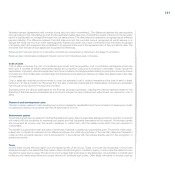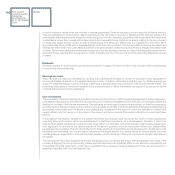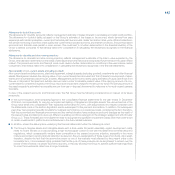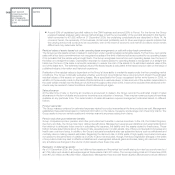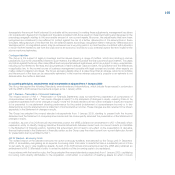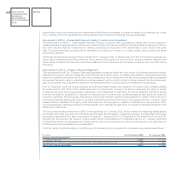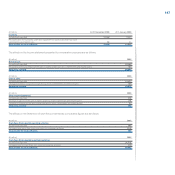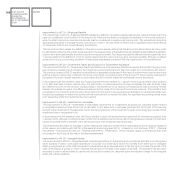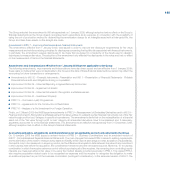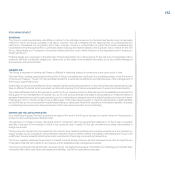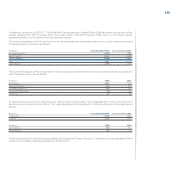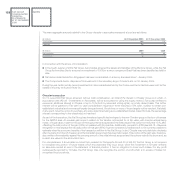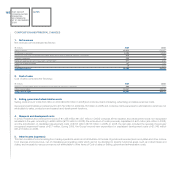Chrysler 2009 Annual Report Download - page 151
Download and view the complete annual report
Please find page 151 of the 2009 Chrysler annual report below. You can navigate through the pages in the report by either clicking on the pages listed below, or by using the keyword search tool below to find specific information within the annual report.
150 FIAT GROUP
CONSOLIDATED
FINANCIAL
STATEMENTS
AT 31 DECEMBER
2009
NOTES
IASB has added a requirement specifying that changes in a parent’s interest in a subsidiary that do not result in the loss of
control must be accounted for as equity transactions and recognised within equity. Moreover, when a parent loses control of
a subsidiary but retains an ownership interest it must initially measure any retained investment at fair value. At the date when
control is lost, the difference between the fair value and the carrying amount of the retained interest must be recognised in
income statement. Finally, the amendment to IAS 27 requires losses pertaining to non-controlling interests to be allocated to
non-controlling interest equity, even if this results in the non-controlling interest having a deficit balance. The new rules will apply
prospectively from 1 January 2010.
As part of its 2008 annual improvements project, the IASB issued an amendment to IFRS 5 – Non-Current Assets Held for Sale
and Discontinued Operations. This amendment, to be applied prospectively from 1 January 2010, requires an entity that is
committed to a sale plan involving loss of control of a subsidiary to classify all the assets and liabilities of that subsidiary as held
for sale, regardless of whether the entity will retain a non-controlling interest in its former subsidiary after the sale.
On 31 July 2008 the IASB issued an amendment to IAS 39 – Financial Instruments: Recognition and Measurement which is to
be applied retrospectively from 1 January 2010. The amendment clarifies how existing principles determining whether a hedged
risk or portion of cash flows is eligible for designation should be applied in particular situations. When applied this amendment
will not lead to significant effects on the Group’s financial statements.
On 27 November 2008 the IFRIC issued interpretation IFRIC 17 – Distributions of Non-cash Assets to Owners that will
standardise practice in the accounting treatment of the distribution of non-cash assets to owners. In particular, the interpretation
clarifies that a dividend payable should be recognised when the dividend is appropriately authorised and that an entity should
measure this dividend payable at the fair value of the net assets to be distributed. Finally, an entity should recognise the
difference between the dividend paid and the carrying amount of the net assets used for payment in income statement. The
interpretation is effective prospectively from 1 January 2010.
On 29 January 2009 the IFRIC issued the interpretation IFRIC 18 – Transfers of Assets from Customers that clarifies the
accounting treatment to be followed for agreements in which an entity receives from a customer an item of property, plant and
equipment that the entity must then use either to connect the customer to a network or to provide the customer with ongoing
access to a supply of goods or services (such as a supply of electricity, gas or water). In some cases, the entity receives cash
from a customer which will then be used to acquire or construct the item of property, plant and equipment to be used to fulfil
the requirements of the contract. The interpretation is effective prospectively from 1 January 2010.
On 16 April 2009 the IASB issued a series of amendments to IFRS (Improvements to IFRSs). Details are provided in the following
paragraphs of those identified by the IASB as resulting in accounting changes for presentation, recognition and measurement
purposes, leaving out any amendments regarding changes in terminology or editorial changes which are likely to have minimal
effects on accounting and amended standards or interpretations not applicable to the Group. These improvements had not yet
been endorsed by the European Union at the date of these financial statements.
IFRS 2 – Share-based Payment: this amendment, applicable from 1 January 2010, clarifies that following the change made
by IFRS 3 to the definition of a business combination, the contribution of a business on the formation of a joint venture and
the combination of entities or businesses under common control do not fall within the scope of IFRS 2.
IFRS 5 – Non-current Assets held for sale and Discontinued Operations: this amendment, which shall be applied prospectively
from 1 January 2010, clarifies that IFRS 5 and other IFRSs that specifically refer to non-current assets (or disposal groups)
classified as held for sale or discontinued operations set out all the disclosures required in respect of those assets or
operations.
IFRS 8 – Operating Segments: this amendment, effective from 1 January 2010, requires an entity to report a measure of total
assets for each reportable segment if such amount is regularly provided to the chief operating decision maker. Before the
amendment, disclosure of total assets for each segment was required even if that condition was not met.
IAS 1 – Presentation of Financial Statements: this improvement, effective from 1 January 2010, amends the definition of
a current liability contained in IAS 1. The previous definition required liabilities which could be extinguished at any time by



